Mosses are known for their connection to the older plants. Therefore, many experts suggest, it is the most ancient plant on the planet. More than 10,000 species of the Moses are found to date. They live in the small terrestrial and can be found all over the world.
About Moss Aquarium Plants
There are several types of moss plants discovered to date. For example, the java moss is a moss plant found in Southeast Asia. They are mostly used in freshwater aquariums.
The demand for java mosses is very high. The key highlights of the java mosses are, they are easily adaptable and found in all kinds of water.
Due to their long life, they are used in the various types of the aquarium. You can even have them in the saltwater aquarium. It will thrive without any special life support.
Another important factor that makes java moss unique among the aquarium plant is the growth rate. They are known for the fastest growing plant in the aquarium.
They grow in the carpet shape with the dense leaf. The plant doesn’t require much maintenance. However, the plant may require a flat surface to build the natural texture.
It should not float in the water. Anchor them properly with the help of the stones, rocks, or driftwood at the bottom.
Table of Contents
- About Moss Aquarium Plants
- What are the best moss Aquarium Plants?
- 1. Java Moss (Taxiphyllum Barbieri)
- 2. Star Moss (Syntrichia Ruralis)
- 3. Christmas Moss (Vesicularia Montagnei)
- 4. Flame Moss (Taxiphyllum)
- 5. Willow Moss (Fontinalis Antipyretica)
- 6. Peacock Moss (Taxiphyllum sp.)
- 7. Pellia Moss (Monosolenium Tenerum)
- 8. Weeping Moss (Vesicularia Ferriei)
- 9. Taiwan Moss (Taxiphyllum Alternans)
- 10. Riccia Moss (Riccia Fluitans)
- 11. Phoenix Moss (Fissidens fontanus)
- 12. Marimo Moss Ball
- FAQs
- Benefit from using Mosses in a tank
- How to maintain Mosses Aquarium Plants?
- Suitable Tankmates of aquarium mosses
- Enemies of aquarium mosses
- Care Of Aquarium Mosses
- Conclusion:
What are the best moss Aquarium Plants?
1. Java Moss (Taxiphyllum Barbieri)
Java Moss has a special structure and growth rate that makes this Aquarium Mosses one of the popular plants on the list. It is easy to care about. The green leaf, small texture, and dense structure make the java moss easy to anchor at the bottom of the aquarium.
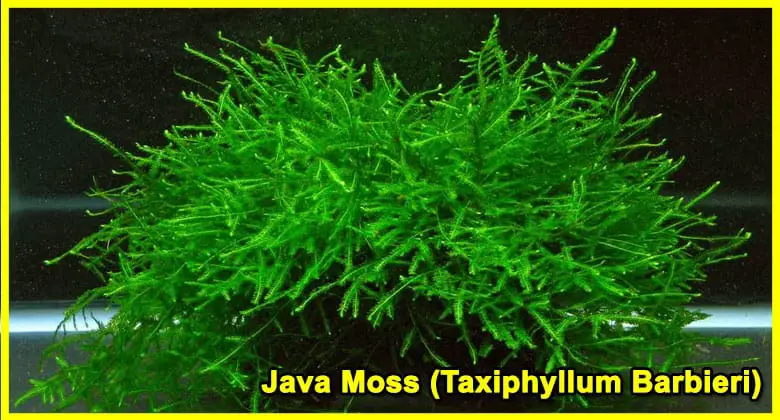
| Scientific Name | Taxiphyllum barbieri |
| Origin | South East Asia |
| Lighting Needs | Low |
| Temperature | 59-82°F (15-28°C) |
| CO2 | Low |
| Water Conditions | pH 5-8 |
| Average Size | 3-10 inches |
| Growth Rate | Slow to Medium |
| Placement | Mid and Foreground |
| Difficulty | Easy |
They are suitable for the shrimp tank, where you can anchor the plant with the help of the rock or the driftwood and create the natural plant effect in the aquarium.
During the maintenance of the plant, trim some for the branches as the plant may grow exponentially and may grow outside of the tank.
- Java Moss Ultimate Guide on Planting, Maintains and Care
- Is Java Moss Good for Betta Fish?
- Is Java Moss Easy to Grow? (Guide for Beginners)
- Is Java Moss Good for Goldfish? (Helpful Tips)
- Is Java Moss Good for Guppies? (Useful Tips)
- Is Java Moss Good for Shrimps?
- How to Clean Algae from Java Moss?
- Why is My Java Moss Turn Brown?
- Is Java Moss Good for Turtle?
- Is Brown Java Moss Dead?
- Is Java Moss a Low Light Plant?
- Does Java Moss Produce Oxygen in The Aquarium?
- Does Java Moss Absorb Nitrates?
- Can I Grow Java Moss Out of Water?
- How to Plant Java Moss in Substrate? (Attachment Guide)
- Can I Grow Java Moss in A Jar?
- Water Conditions for Java Moss (Best Guide for Plant Lovers)
- Can Cherry Shrimp Eat Java Moss?
And Read More Java Moss Articles
2. Star Moss (Syntrichia Ruralis)
The Star moss is great aquarium plant suits to all kinds of environment and water conditions. It is not a native plant, but the plant adapts to the new environment easily and grows rapidly in the aquarium. When the plant is fully submerged in the aquarium, it lives around 3 months.
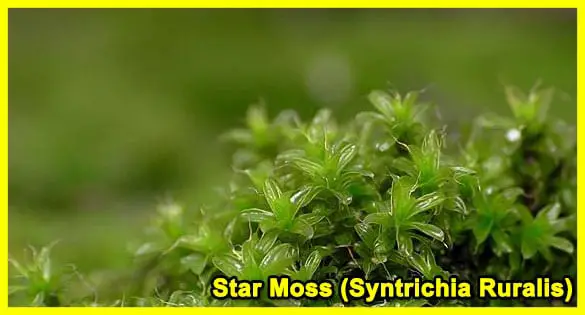
| Scientific Name | Syntrichia Ruralis |
| Origin | South East Asia |
| Lighting Needs | Medium – high indirect light |
| Temperature | 55-80°F (12-26°C) |
| CO2 | Low |
| Water Conditions | pH 5- 7.5 |
| Average Size: | 0.5-2 inches |
| Growth Rate | Slow to Medium |
| Placement | Mid and Foreground |
| Difficulty | Easy – Medium |
Star moss grows very attractive and complements the fish with the beautiful scenery. Frequently trim the plants to keep them in good shape. Fish like the plants in the aquarium. They like to hide behind the plants, nesting, and playing with other fish.
- Star Moss Ultimate Guide on Planting, Maintains and Care
- How can I Identify Star Moss? (Identification Guide)
- How to Grow Star Moss? (Easy to grow guide for Beginners)
- Does Star Moss Make Oxygen?
- Why is my Star Moss Plant Dying?
- Is Star Moss Easy to Grow?
- Why is My Star Moss Turning Brown?
- Are Star Moss Good for Guppies?
- Is Star Moss Good for Betta Fish?
- Is Star Moss Good for Goldfish?
- Is Star Moss Good for Shrimps?
- Water Conditions for Star Moss Aquarium Plant
- How to Clean Algae from Star Moss Aquarium Plant?
And Read More Star Moss Articles
3. Christmas Moss (Vesicularia Montagnei)
The Christmas moss plant gives an appealing texture to the aquarium. The tiny leaf of the plant grows rapidly and covers the entire tank, which enhances the appearance of the fish tank.
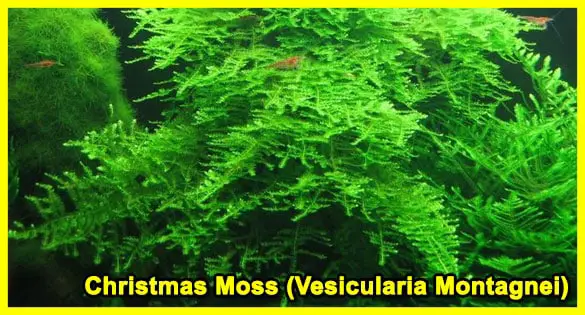
| Scientific Name | Vesicularia Montagnei |
| Origin | South America |
| Lighting Needs | Medium – high indirect light |
| Temperature | 70-90°F (21-32°C) |
| CO2 | Low |
| Water Conditions | pH 5- 7.5 |
| Average Size | 3 – 5+ |
| Growth Rate | Slow to Medium |
| Placement | Mid and Foreground |
| Difficulty | Easy – Medium |
The Christmas moss would require the right amount of fertilizer and CO2 to grow. This can be problematic as some fish have a low tolerance rate when it is CO2 around. Also, the shrimp cannot tolerate the rapid growth of the pH level in the water.
Christmas Moss can sustain in the cooler water. You can have the Christmas plant in the cold water fish tank. Such as goldfish, betta can live in the water where you have beautiful Christmas moss plants. Just ensure that you feed the fish on time. The plant may become their routine snacks if they are not fed properly.
The plant needs bright light to steady growth while in the aquarium. The Christmas moss is the best Aquarium Mosses for the fish tank.
- Christmas Moss Ultimate Guide on Planting, Maintenance and Care
- Is Christmas Moss Easy to Grow?
- Why is My Christmas Moss Turning Brown?
- Why is My Christmas Moss Dead? (Preventing Methods)
- How to Clean Algae from Christmas Moss? (Rid of Algae)
- Is Christmas Moss Good for Goldfish?
- How Can I Grow Christmas Moss on Substrate?
- Water Conditions for Christmas Moss (Growing Guides)
- Does Christmas Moss Make Oxygen?
- Is Christmas Moss Good For Guppies?
- Is Christmas Moss Good For Shrimps?
- Is Christmas Moss Good for Betta Fish Tank?
- Do Christmas Moss Need Foods? (Plant Fertilizer)
- How to Reproduce Christmas Moss? (Propagate Method)
- Lightning Requirements for Growing Christmas Moss
And Read More Christmas Moss Articles
4. Flame Moss (Taxiphyllum)
Flame moss is found in Asia. The plant appears like the forest fire spreading, and it has a large flame on the top. Unlike the other aquarium moss, the flame moss grows vertically. Each leaf of the flame moss has its growth speed. You will see them growing faster in the vertical form compare to the horizontal space.
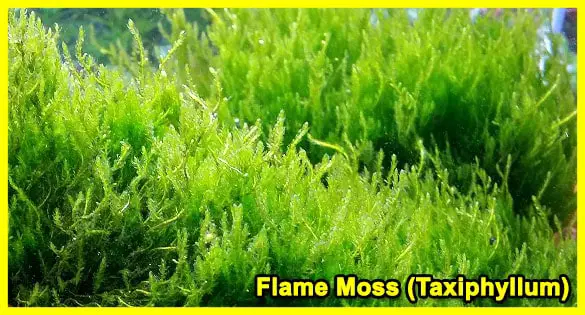
| Scientific Name | Taxiphyllum |
| Origin | Asia |
| Lighting Needs | Low |
| Temperature | 68-90°F (20-32°C) |
| CO2 | Low |
| Water Conditions | pH 5- 7.5 |
| Average Size | 3 – 10+ |
| Growth Rate | Slow |
| Placement | Mid and Foreground |
| Difficulty | Easy |
The flame moss appears great when it is kept with other bushes that look great. The plant doesn’t require much care. Once it is planted in the aquarium, it will keep growing naturally.
You may require to trim them down if it penetrates the water and starts growing outside the tank.
- Flame Moss Ultimate Guide on Planting, Maintenance, and Care
- Is Flame Moss Easy to Grow? (Complete Guide for Beginners)
- Is Flame Moss Good for Goldfish?
- Is Flame Moss Good for Guppies?
- Is Flame Moss Good for Shrimps in My Aquarium Tank?
- Is Flame Moss Good for Betta Fish?
- How to Plant Flame Moss in Substrate? (Attachment Guide)
- Does Flame Moss Plant Make Oxygen?
- Is Flame Moss Good for Turtles in my Aquarium?
- Why is my Flame Moss Turning Brown?
- How to Get Rid of Snails on Flame Moss?
- How Can I remove the Algae from Flame Moss?
- Does the Flame Moss Need CO2? (How Does It Get CO2)
And Read More Flame Moss Articles
5. Willow Moss (Fontinalis Antipyretica)
Willow moss is an amazing aquarium plant. It can find everywhere on the earth. They are not sea plants. It can find in the rivers, lakes, and many other water bodies. They have developed new genes that adopt the new environment easily and thrive in the different kinds of water surface.
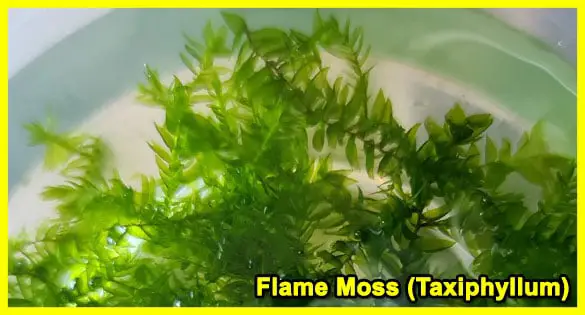
| Scientific Name | Fontinalis Antipyretica |
| Origin | North America |
| Lighting Needs | Low to moderate |
| Temperature | 59° – 82° F (15° – 28° C) |
| CO2 | Low |
| Water Conditions | pH 5.5 – 7.5 |
| Average Size | 3 – 10+ |
| Growth Rate | Fast Grow |
| Placement | Mid and Foreground |
| Difficulty | Easy |
When the Willow moss grows, it covers the entire tanks with the green leaf and depicts the natural vegetation in the aquarium. The branches easily grow to up to 60 cm in length. Generally, the plant grows in the vertical form when there is favorable condition around.
6. Peacock Moss (Taxiphyllum sp.)
If you have aquarium plants, then without Peakcock moss, your aquarium setup is incomplete. The most attractive mosses in the category make the freshwater aquarium alive. They produce a perfect bed sheet in the tank where the fish can lay their egg on the leaf.
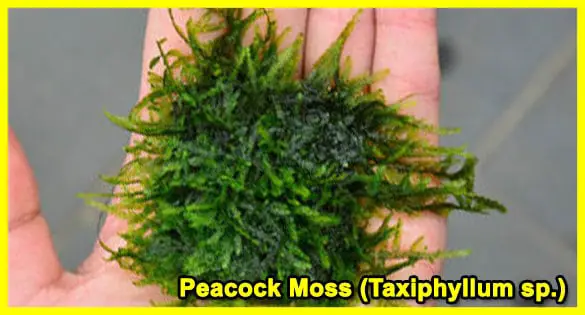
| Scientific Name | Taxiphyllum sp. |
| Origin | Farmed in Asia, but indigenous to Southeast Asia |
| Lighting Needs | Low to moderate |
| Temperature | 65° – 77° F (18.3° – 25° C) |
| CO2 | Not necessary but recommended |
| Water Conditions | pH: 5.0 – 7.5 |
| Average Size | 15 cm |
| Growth Rate | Normal |
| Placement | Mid and Foreground |
| Difficulty | Easy |
As well as the shrimp can find the natural habitat in the aquarium. It is suitable for the breeding tanks where fish will find plenty of space to lay their eggs and grow their community.
The Peacock Moss is easy to care for and doesn’t require special attention. They are immune to grow in the different types of water chemistries.
- Peacock Moss Ultimate Guide: Planting, Maintenance, and Care
- How to Grow Peacock Moss? (Complete Guide for Beginners)
- Is Peacock Moss Good for Goldfish?
- Is Peacock Moss Good for Guppies?
- Is Peacock Moss Good for Shrimps?
- Is Peacock Moss Good for Turtles?
- Is Peacock Moss Good for Betta Fish?
- How to Control Algae Growth on Peacock Moss?
- How to Reproduce Peacock Moss? (Propagation Method)
- How can I Get Rid of Snails in Peacock Moss Aquarium?
- How to Plant Peacock Moss in Substrate? (Attachment Guide)
- Does Peacock Moss Need Light?
- Is Peacock Moss Safe for Cats?
- Why is My Peacock Moss Die?
- Does Peacock Moss Need Fertilizer?
And Read More Peacock Moss Articles
7. Pellia Moss (Monosolenium Tenerum)
The Pellia Moss plant produces delicate, beautiful leaves that look awesome when placed in the tank. They don’t require much caring and capable of staying in different kinds of water conditions.
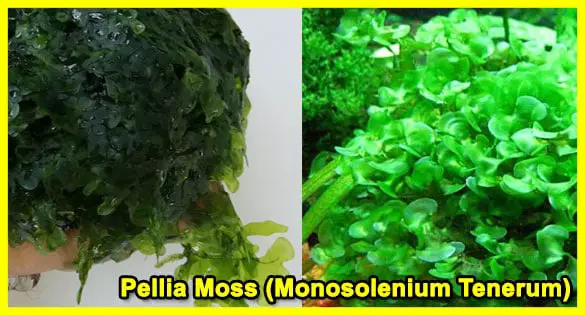
| Scientific Name | Monosolenium Tenerum |
| Origin | Southeast Asia |
| Lighting Needs | Low to moderate |
| Temperature | 65° – 77° F (18.3° – 25° C) |
| CO2 | Low |
| Water Conditions | pH: 5.0 – 7.5 |
| Average Size | 5- 10 cm |
| Growth Rate | Normal |
| Placement | Mid and Foreground |
| Difficulty | Easy to moderate |
Due to their soft leaves, they are considered very brittle plants. If you put the large fish in the tank, the movement of fish may mess the plant leaves, and eventually, it will be damage. Use the Pellia Moss in the aquarium with the slower-moving fish.
8. Weeping Moss (Vesicularia Ferriei)
The Weeping Moss has the origin in China. The ancient Chinese people used to put the Weeping moss in the aquarists due to its great appearance and ability to adapt to the different water conditions.
The plant can grow up to 3 cm high when it is kept in the right environment. The width will grow up to 5 cm.
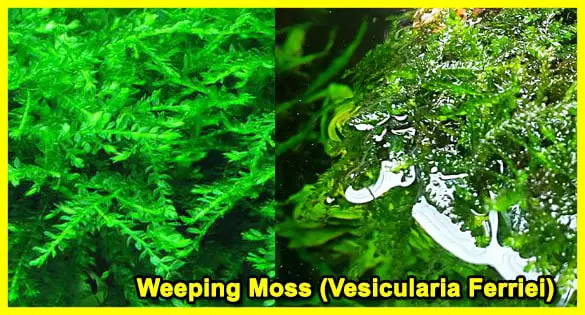
| Scientific Name | Vesicularia Ferriei |
| Origin | Asia |
| Lighting Needs | Medium |
| Temperature | 65° – 77° F (18.3° – 25° C) |
| CO2 | Low |
| Water Conditions | pH: 5.0 – 7.5 |
| Average Size | 3-5 cm |
| Growth Rate | Normal |
| Placement | Mid and Foreground |
| Difficulty | Easy to moderate |
These are slow grower plants. You will not see a big change in plant growth instantly. The slower growth is also suitable for the small size aquarium.
You do not have to put effort into cleaning or maintain the plant. They look similar to the Christmas moss. The Weeping moss leaves grow smaller. You can’t see sudden growth in the leaves.
- Weeping Moss Ultimate Guide on Planting, Maintains and Care
- How to Grow Weeping Moss? (Complete Guide for Beginners)
- Does Weeping Moss Generate Oxygen?
- How to Plant Weeping Moss in the Substrate (Attachment Guide)
- Is Weeping Moss Good for Goldfish?
- Is Weeping Moss Good for Guppies?
- Is Weeping Moss Good for Shrimps?
- Is Weeping Moss Good for Turtles in my Aquarium?
- Is Weeping Moss Good for Betta Fish?
- How to Control Algae Growth on Weeping Moss?
- How to Reproduce Weeping Moss? (Propagation Method)
- Water Conditions for Weeping Moss
- How do I keep Snails out of my Weeping Moss Aquarium?
And Read More Weeping Moss Articles
9. Taiwan Moss (Taxiphyllum Alternans)
Taiwan moss is originally from Taiwan. The triangle shape shoots are easily different plants from others. When the plant is placed in the water, they become a curved shape. The unique aquarium moss has a very tiny bunch of looks.
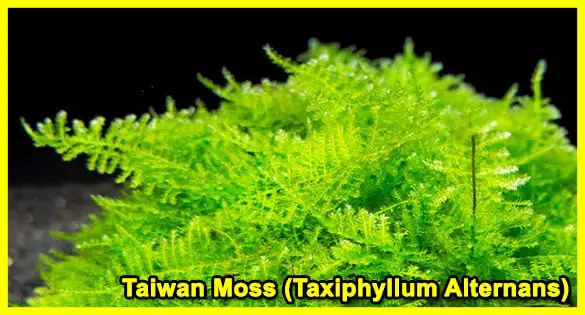
| Scientific Name | Taxiphyllum Alternans |
| Origin | Eastern Asia |
| Lighting Needs | Low |
| Temperature | 59° – 82° F (15° – 28° C) |
| CO2 | Low |
| Water Conditions | pH: 5.5 – 7.5 |
| Average Size | 5-10 cm |
| Growth Rate | Normal |
| Placement | Mid and Foreground |
| Difficulty | Easy to moderate |
Over time it becomes large and spread across the given space. You can have them in the freshwater, and they grow at a steady speed. It is easy to keep plants, and it doesn’t require much effort.
The leaves become bright and juicy over time with the green and exuberant bushes. Use the soft water and the bright light during the day to make them thrive in the natural habitat.
Bright illumination is necessary to allow the moss to grow, else it will change the color, and the growth rate will decrease over time.
10. Riccia Moss (Riccia Fluitans)
The Riccia Moss is widely found in the various water bodies in Europe, Asia, Africa, and South America. The beautiful-looking plant comes with bright green balls.
The lightweight of the plant allows it to float comfortably on the water surface. When the plant is kept in the aquarium, it will cover the top surface of the water.
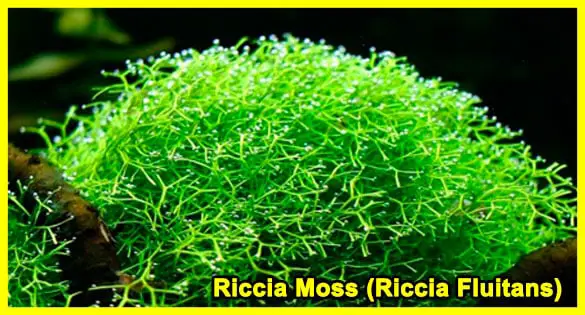
| Scientific Name | Riccia Fluitans |
| Origin | Asia |
| Lighting Needs | Low |
| Temperature | 20 – 26 °C (68 – 79 °F) |
| CO2 | Low |
| Water Conditions | pH: 5.5 – 7.5 |
| Average Size | 1 Inch |
| Growth Rate | Medium |
| Placement | Mid and Foreground |
| Difficulty | Moderate |
However, most of the aquarium owners use Riccia moss to cover the ground of the tank. You may have to use the stone, rocks, or driftwood or simply pin them at the bottom of the tank to keep them at the fixed place.
If you are looking to make a small size hillock in your tank, this plant is suitable as they slowly cover the stone and look beautiful.
The Riccia moss grows quickly in the soft water. The water with the neutral or weakly alkaline reaction the plant will live forever. Avoid placing the Riccia in the water hardness higher than 8 degrees.
It will decrease the growth and reduce the life of the plant. When the water condition is right, the plant reproduces quickly and covers all water surfaces. It will look like a green carpet has occupied the water.
11. Phoenix Moss (Fissidens fontanus)
The Phoenix Moss is normally found in North America. They grow like a hillock or a fountain. The Phoenix Moss grows quickly in the aquarium and covers the entire tank with fresh green leaf.
When you put them around the rock, they cover the entire rock in a short period.
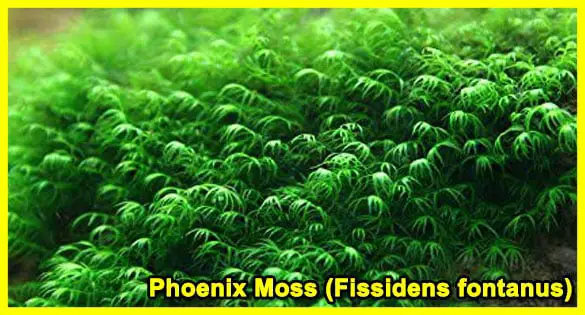
| Scientific Name | Fissidens fontanus |
| Origin | North America |
| Lighting Needs | Low |
| Temperature | 65° – 77° F (18.3° – 25° C) |
| CO2 | Low |
| Water Conditions | pH: 5.0 – 7.5 |
| Average Size | 1 -3 Inch |
| Growth Rate | Medium |
| Placement | Mid and Foreground |
| Difficulty | Moderate |
It is suitable for beginners who want to set up their aquarium with the beautiful plant in it. The fast growth of the plant allows you to decorate your aquarium in the natural forest.
The plant is also be placed at the bottom of the tank covering the ground. When it is placed on the ground, it resembles a green fountain.
- Phoenix Moss Ultimate Guide On Planting, Maintains & Care
- Is Phoenix Moss Easy To Grow? (Beginner’s Guide)
- Is Phoenix Moss Good For Goldfish?
- Is Phoenix Moss Good For Shrimps?
- Is Phoenix Moss Good For Guppies?
- How To Reproduce Phoenix Moss? (Propagate Method)
- Can I Dry Start Phoenix Moss? (Best Method)
- How To Grow Phoenix Moss In Substrate?
- How To Clean The Algae on Phoenix Moss?
- Water Conditions For Phoenix Moss? (Best Guideline)
- Why is My Phoenix Moss Dying? (Recovery Tips)
- Do Snails Eat Phoenix Moss? (Rid of Snails)
And Read More Phoenix Moss Articles
12. Marimo Moss Ball
Marimo Moss Ball, also known as the Seaweed ball found in Japan. They are a rare form of spherical algae found in the deep ocean. The plant is made of green tiny leaves that cover themselves in a circular shape.
No hard surface is inside, which makes them unique. It is solid algae packed in thick layers.
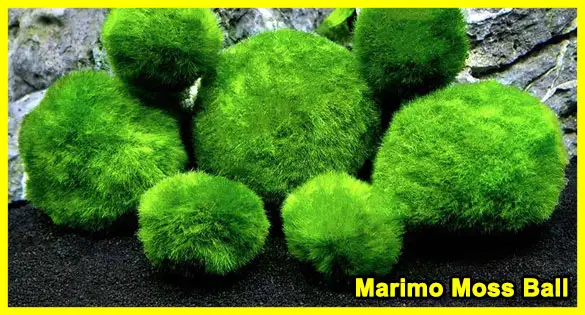
| Scientific Name | Aegagropila linnaei |
| Origin | Japan |
| Lighting Needs | Low |
| Temperature | 10° – 28° C° |
| CO2 | Low |
| Water Conditions | pH: 6.0 – 8.5 |
| Average Size | 3-4cm |
| Growth Rate | Very slow, only 5 mm / year |
| Placement | Foreground |
| Difficulty | Moderate |
They grow outwards, covering the entire surface. As they grow, the size of the ball becomes bigger and densely covered with green algae. The growth rate of the plant is prolonged.
They grow radically outward at a snail’s pace. In a year, they will grow to about 5mm. At this speed, you will hardly notice the growth of the plant.
In the freshwater lakes where they are kept in the natural habitat, the plant grows rapidly. The growth rate in this region is between 8 and 12 inches in diameter.
- Marimo Moss Ball Ultimate Guide on Planting, Maintains and Care
- Is Marimo Moss Ball a Pet?
- Do Marimo Moss Balls Need Foods?
- Are Marimo Moss Balls Good for Guppies?
- Is Marimo Moss Ball Good for Betta Fish?
- Is Marimo Moss Ball Easy to Grow?
- Is Marimo Moss Ball Good for Gold Fish?
- Is Marimo Moss Ball Good for Shrimps?
- Are Marimo Moss Balls Good for Turtle Tank?
- Are Marimo Moss Balls Good for an Aquarium?
- Water Conditions for Marimo Moss Balls
- Why Is My Marimo Moss Ball Turning Brown?
- Are Marimo Moss Balls Good For Algae Eaters?
- Can My Marimo Moss Balls Die?
- How to Treat My Sick Marimo Moss Balls?
- How to Reproduce Marimo Moss Balls (Propagate Methods)?
- How to Make a Unique Marimo Moss Ball in a Jar?
- Is Marimo Moss Ball a Low Light Plant?
- Are Marimo Moss Balls Illegal in Australia? (What You NEED To Know?)
- How to Clean Algae from Marimo Moss Balls?
- Do Snails Eat Marimo Moss Balls? (Prevent Snails Eating Moss Ball)
And Read More Marimo Moss Ball Articles
FAQs
-
What is the easiest aquarium moss to grow?
The Taxiphyllum Barbieri, also known as Java moss, is the easiest moss to grow in the aquarium. These plants are easy to grow in all kinds of water bodies. Please do not keep them in extreme temperatures or under heavy lighting.
-
How can I make my aquarium moss grow faster?
Several factors affect the growth of the aquarium moss. One of the primary factors is the water condition.
Aquarium moss absorbs the required minerals and essential substances for the growth of the water. When the plant is not in the right habitat, it will start decaying, and you will experience the growth rate is decreasing.
Following are some of the factors that determine the growth of the aquarium moss.
1) The aquarium mosses can become easy food for the large fish due to their tiny leaves. Many fish eats the plants as they are tasty snacks for them. Having omnivorous fish in the tank with the aquarium moss would not be a good idea.
Most of the moss plant will be eaten by the fish, and there will be no moss in the tank. Use the moss only in the tank where you have small fish. Small-size fish do not eat the moss, allowing the plant to grow in the natural habitat.
2) Use regular trimming practice to keep the moss grow in the right shape. The trimming also reduces the unwanted growth and makes the moss grow where it is important. Aquarium moss will look healthy and alive after the trimming.
3) You should replace 25% of the water every week to supply the fresh water in the aquarium. The freshwater contributes to the growth of the mosses.
In their natural habitat, the freshwater is always disbursed from the different water bodies. This freshwater brings nutrition and essential substance that improves the mass and make the moss grow faster.
4) The water temperature makes the aquarium moss speed up the growth. When the water is moderated at the right temperature, it will make the mosses rapidly grow and sustain longer.
The moss requires a water temperature below 24-degree Celsius.
Therefore, you should also think about having the right type of fish in the aquarium if you are willing to grow the aquarium moss quickly. Some bettas may require high temperature than this.
If you have the bettas in the tank, the growth rate of the moss will be a bit slower. The suitable temperature is between 70 to 75 degrees Fahrenheit.
-
What fish eat Moss plants?
Goldfish, Mbuna, Oscars, Uaru spp, Leporinus spp, The Common Pleco, Silver Dollars, Buenos Aires Tetras, Scats, and Monos. These are moss plant-eater fish. All the omnivorous fish eats the plants when they are not fed properly.
When you have these fish in the aquarium, you should have a proper maintenance plan for the fish and the plants. Use the auto-feeding machines to keep the fish full all the time. If they are hungry, the first thing they do is eat plants.
-
What are the Common Problems of Mosses Aquarium Plants?
The moss plants are susceptible to change in the aquarium. They can sense the water condition quickly. When the water is not suitable, the roots of the plant become brown.
In some moss plants, you will notice the leaves turn yellow and eventually breaks from the plant. The growth rate of the plant also decreases.
The decrease in the growth rate is due to the less nutrition in the water, temperature increase, high stress generating factors such as fish-eating the plants, or less bright light in the aquarium.
If you do not have a proper maintenance plan for the aquarium, the black algae will cover the tank, and it would be challenging for the plant to sustain itself in the tank. If you do not clean these algae in time, they will start killing the leaves.
Holes in the leaves are another common reason why the plant doesn’t grow. It will speed up the disintegration of the plant, and eventually, the moss will die.
The holes in the leaves are a sign of the disease developed in the plant that causes it to break the gene.
-
How to attach & decoration methods mosses?
The aquarium moss is found in different shapes sizes. Depending on the plant, use the holding material to stick them on the ground. The moss is a lightweight plant.
When they are not tied properly to the rock or the ground, they will start floating and reach the top of the water.
The most common way to place the moss in the tank is the wrapping them around the rock with the thread. Cover the rock properly and leave them in the tank.
Decide the place in the tank where it is not touching other plants or the aquarium pump or filter. The equipment in the aquarium may damage the plants.
Use the driftwood to tie the plant and arrange them not to harm the fish. Tie them closely so they will not float on the surface of the water. Use the thread to keep the moss in place.
If you do not want to tie the moss using the thread, then use the rocks to jam them in-between. Ensure that they are kept properly, so they will not lose.
If the two moss plants are kept nearby, they will grow to attach themselves and may not look good in the aquarium.
Use the different types of moss plants to create the illusion of the dept. in the aquarium. It will look like the dense forest growing in the natural habitat.
Some prefer having the moss plants in the foreground with the small space between the fish to swim. However, this kind of decoration is not so popular.
Benefit from using Mosses in a tank
Moss plants are popular among aquarium lovers. These plants make the aquarium look alive. Moss plants live longer if they are kept in the perfect environment.
These plants are most useful when you want to build a natural habitat in the aquarium. The plants make great for improving the water condition as well as provide oxygen to the fish.
The moss plants are also eaten by the fish when there is no sufficient food provided to them if you plan to travel for a long vacation and not sure how to feed the fish when you are away.
Also, some of the auto-feeding devices are not reliable. If something goes wrong, the fish may not get the food during this period.
The fish in the aquarium may die due to less food. In such a case, the moss plant may save their life. When the fish do not get the food, they start eating the plants.
So before leaving home, put the moss plant in the aquarium. It will help the fish to eat the plant if in case sufficient food is not available around.
How to maintain Mosses Aquarium Plants?
You might have the moss in the aquarium plants. This plant requires proper maintenance. Use the below suggestions to maintain the moss plant in your aquarium.
1) Cleaning:
Moss plant attracts the waste product. It may get stuck on the leaves of the moss plant. The waste product generally resides in a low area where the flow of the water is less.
Also, due to the weight of the waste product, it covers the bottom layer of the water. The excess waste may drop the water quality, which will be harmful to the moss plant growth.
If you find more dirt in the water, then it is time to clean the water and moss plant. Take the whole structure out if the moss is planted on the driftwood or the rock.
Rinse it under the running water. Ensure that the force of the water is not high. Else, it will break the leaves. Remove the dirt and debris stuck in the plant.
2) Trimming:
Moss grows quickly if the water condition is suitable. If it is left alone, it may grow abruptly and cover the entire surface of the aquarium. It should be trimmed with scissors to avoid them spreading in the aquarium and consume more space.
Overgrown moss may also affect fish health. The less swimming space may stress out the fish. The dense moss prevents the lights from reaching the bottom. As a result, the plant will start dying.
Suitable Tankmates of aquarium mosses
The different kinds of shrimps can live around the aquarium mosses. They are very helpful tankmates for the mosses. The shrimps eat all the rubbish that resides around and on the top of the aquarium mosses.
Amano Shrimp eat most of the algae. These algae are hazardous for the mosses. They will shorten the lives of moss and may produce a waste product that reduces the water quality.
Enemies of aquarium mosses
There aren’t many enemies of the aquarium mosses. One of the enemies that you find in the water is the Algae. The Algae covers the leaves of the plant and destroys its appearance and nutrition process.
However, keep the large size fish away from the moss. Most of the omnivorous fish eat moss plants when they are hungry. The small size fish would live comfortably around the moss.
Siamese algae eater fish loves to eat the mosses. So if you have the fish in your aquarium, keep them away from the moss. Most of the moss will be eaten by them if you offer them freely. The fish do not eat the Phoenix Moss.
Care Of Aquarium Mosses
The aquarium mosses require the proper lighting to make them produce the food in the natural environment. More light will help them to grow faster and acquire more energy from the light source.
Additionally, the fertilizer will help them to maintain good health and grow faster. You can find different types of moss fertilizer that support the growth of the aquarium mosses.
Use the pressurized CO2 if you want the moss to grow rapidly. In the natural condition, the moss shows significant growth, but when it is kept in a container with a high amount of CO2 would help the plant to grow faster.
Conclusion:
The Aquarium Mosses are great, and they support the life of the fish. When the fish finds the natural habitat in the water, they feel comfortable and less stressed. Moss plant improves the vegetation in the aquarium and offers great support to the health of the fish.
When the moss is kept in the aquarium, it will allow the fish to stay calm as there will be sufficient food and a hiding place in the aquarium.
